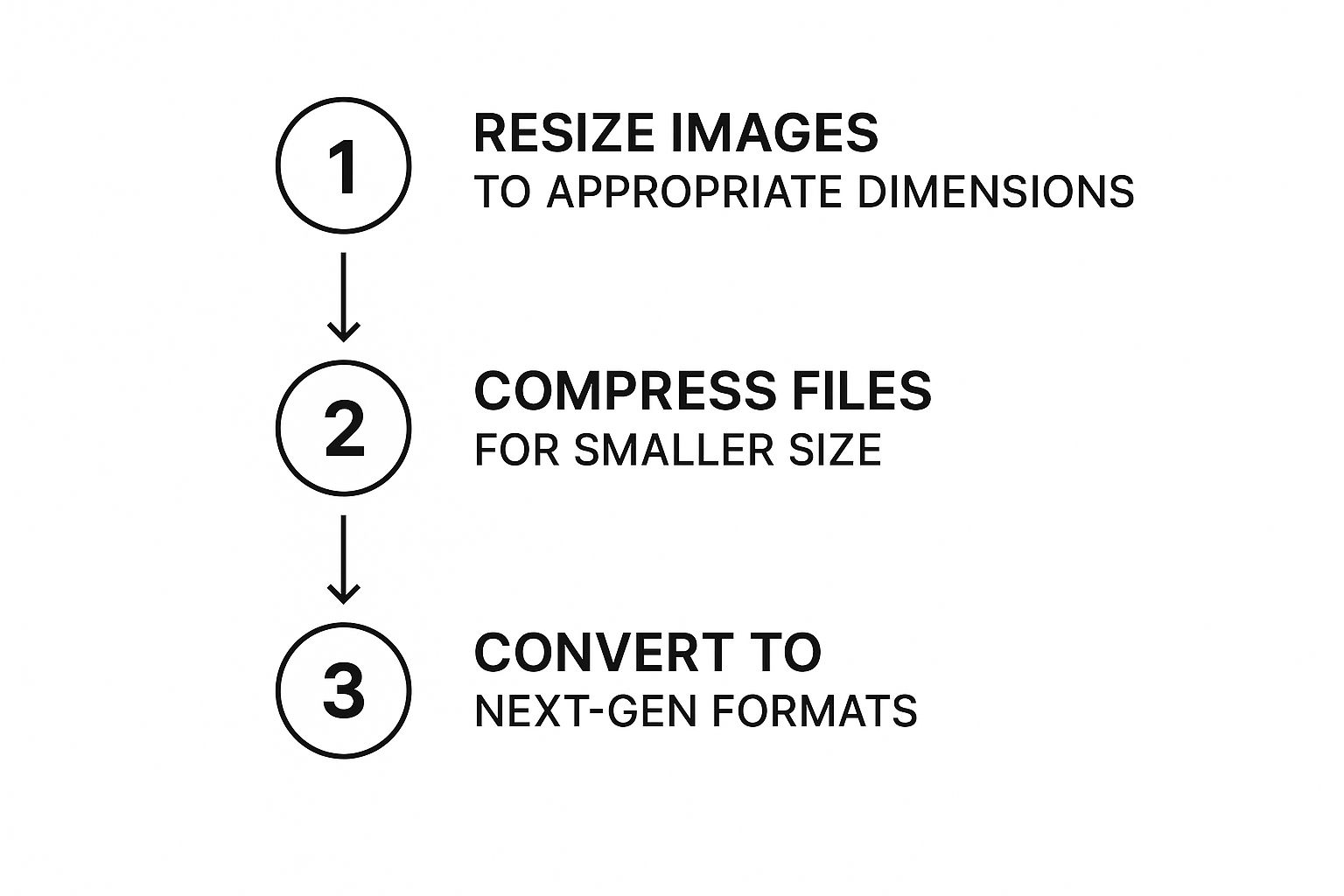Let's be honest, a slow website feels like hitting every red light on your way to an important meeting. Frustrating, right? For your visitors, it can feel like a closed door. In a world where every second counts, your site’s loading time is the first—and sometimes only—impression you get to make. That’s why a professional website speed optimisation service isn't just a technical task to tick off; it's a crucial investment in your online presence.
This guide will walk you through why speed matters so much, what goes into making a site faster, and how you can get started.
Why Website Speed Is More Than Just a Number

It’s easy to think of website speed as just another metric buried in a performance report. But it's so much more than that. Think of it as a direct measure of how much you respect your visitor's time. A quick, responsive website instantly feels professional and considerate. A sluggish one, on the other hand, creates frustration before a visitor has even read a single word.
This isn’t just a feeling; the data tells the same story. Research shows that nearly 47% of internet users expect a website to load in two seconds or less. If it takes longer, many will simply give up and leave. That’s a tiny window to capture someone’s attention. For a bit of perspective, you can discover more insights about UK website performance statistics to see how the top sites perform.
Your First Impression Matters Most
Imagine your website's load time is its digital handshake. A fast, smooth load is a firm, welcoming grip that invites people to look around. A slow, clunky one is a limp handshake that makes them want to back away. When people leave your site almost immediately, that’s called a high "bounce rate," and it’s often caused by a poor first impression.
This initial interaction sets the tone for everything that follows. A great start leads to:
- Better Engagement: When the experience is seamless, visitors are far more likely to stick around, click on other pages, and engage with your content.
- Greater Trust: A professionally optimised site just feels more reliable and secure. This is incredibly important if you're asking for their contact details or selling products.
- Improved Brand Perception: Speed is a huge part of the modern customer experience. A fast site says you're efficient, professional, and you care about serving your audience well.
When it comes down to it, focusing on speed is about putting your visitors first. It's the foundation that supports all your other marketing efforts, helping you get the most out of every single visit.
The Real-World Business Impact of a Faster Website

Investing in your website's speed isn't just about chasing a high score on a performance tool. It's about generating real, measurable results that help your business grow. When you work with a professional website speed optimisation service, those technical tweaks translate into tangible benefits across three key areas.
A quicker site creates a better visitor experience, helps you get noticed by search engines, and makes it easier for people to become customers. Let's explore how each of these plays out.
A First-Class User Experience
The most immediate benefit is a dramatic improvement in user experience. Let's face it, nobody enjoys waiting for a page to load. A fast, snappy website feels professional and inviting. It lets people find what they need without frustrating delays, which keeps them happy and far more likely to stick around.
This simple change has a powerful ripple effect:
- Lower Bounce Rates: When a page loads almost instantly, people don't have a reason to get impatient and hit the back button. They actually stay long enough to see what you have to offer.
- Longer Visits: A smooth experience encourages visitors to click around, explore other pages, and spend more time engaging with your brand.
- Greater Trust: A high-performing site sends a clear message: you're reliable and you respect your audience's time. That's a huge step in building trust.
Better Visibility on Search Engines
Search engines like Google have one main goal: to give their users the best, most relevant results. A huge part of that is ensuring the sites they recommend are a pleasure to use, and speed is high on their list.
Think of it this way: a fast website is a direct signal to search engines that you offer a quality experience. That's why page speed is a confirmed ranking factor, giving faster sites a genuine edge in search results.
So, when you optimise your site's performance, you're not just doing it for your current visitors. It's a smart move to attract new ones. Improving your load times directly boosts your chances of ranking higher, which means more organic traffic coming your way.
Higher Conversion Rates and More Sales
Ultimately, your website needs to drive action—whether that's making a sale, capturing a lead, or getting a new subscriber. Speed is one of the most powerful drivers of conversion. We've all abandoned an online purchase because of a clunky checkout process; that same frustration applies to every page on your site.
The proof is in the data. For example, some studies show that just a one-second delay can reduce conversions by 7%. You can explore more website speed statistics to see just how common this is. By removing friction and making the journey from visitor to customer as smooth as possible, you make it easy for people to say "yes".
What a Website Speed Optimisation Service Does
So, what exactly happens when you hire experts to make your website faster? It’s not about guesswork or flipping a few random switches. A professional website speed optimisation service follows a methodical plan to find and fix the bottlenecks slowing your site down.
It all starts with a deep dive into your website's current performance—think of it as a comprehensive health check. Using specialist tools, an expert will run a full audit to pinpoint exactly what’s causing sluggish load times. This isn't just about getting a vague "fast" or "slow" score; it's about identifying the specific culprits.
The Core Optimisation Process
Once the problem areas are identified, the real work begins. The goal is to make your website as lightweight and efficient as possible, so browsers can load it in the blink of an eye. While every website is different, the process usually involves a few key steps.
Here’s a look at some of the most common and effective techniques a service will tackle:
- Tackling Images and Media: Large, unoptimised images are one of the most common causes of slow websites. A professional will compress your images without sacrificing quality, ensuring they load quickly.
- Minifying Code: Your site is built with code (like CSS and JavaScript). Minification is the process of cleaning up this code by removing unnecessary spaces and characters, which makes the files much smaller and faster to download.
- Leveraging Browser Caching: This clever technique tells a visitor’s browser to "remember" parts of your website, like your logo and layout. When they return, their browser doesn't need to re-download everything, making subsequent visits feel almost instant.
Optimising Images for Peak Performance
Images are vital for keeping visitors engaged, but they need to be handled carefully. The infographic below shows a typical three-step workflow for making sure your visuals are helping, not hurting, your site's speed.

This simple flow—resizing, compressing, and converting—ensures every single image is as lean as it can be without losing its impact. This is a cornerstone of professional optimisation. For platforms like WordPress, there are specific techniques that can deliver incredible results. You can find out more about our dedicated WordPress speed optimisation service and see how these methods are put into practice.
Advanced Strategies for a Faster Site
Beyond the basics, a thorough service will also look at your site’s entire delivery infrastructure. This is where some of the more advanced, high-impact strategies come into play.
A key part of this is often setting up a Content Delivery Network (CDN).
Think of a CDN as a global network of servers that store copies of your website. When someone visits your site, the content is delivered from the server closest to them, which dramatically reduces loading times.
It’s all part of a structured, multi-layered approach. By combining foundational fixes like image optimisation with advanced solutions like a CDN, a professional service methodically improves everything holding your website back. The result is a faster, smoother experience for every visitor, no matter where they are in the world.
Understanding Key Website Performance Metrics

If you've ever glanced at a website performance report, you know it can look like a wall of technical terms. It’s easy to feel a bit lost. But the good news is you don't need to be a developer to understand what makes a site feel fast or slow.
The trick is to focus on a handful of key measurements that reflect what your visitors actually experience.
Thankfully, Google has helped simplify things with its Core Web Vitals. You can think of these as the three most important vital signs for your website's health. They’re specifically designed to measure how a real person perceives your site's loading speed, interactivity, and visual stability.
Understanding these metrics helps you have much better conversations with a website speed optimisation service because you’ll know exactly what they're trying to achieve. Let's break them down in simple terms.
The Three Core Web Vitals Explained
These three pillars paint a clear picture of your site's performance from your visitor's perspective.
- Largest Contentful Paint (LCP): This sounds complicated, but it’s really just about loading speed. It answers the question: “How long does it take for the most important content on the page to appear?” This is usually a large image or the main block of text. A fast LCP makes your page feel like it's loaded quickly.
- First Input Delay (FID): This one is all about responsiveness. In simple terms: “When I click a button or a link, how long does it take for the website to start responding?” A low FID means your site feels interactive and not frozen or laggy.
- Cumulative Layout Shift (CLS): This measures visual stability. It asks: “How much does the page content jump around unexpectedly while it loads?” We’ve all been there – you go to tap a button, and an ad loads above it, pushing the button down the page. A low CLS prevents that from happening.
Getting these three metrics into the 'Good' range is the main goal of any serious speed optimisation project. It’s a direct path to a better user experience. If you’re curious about tracking these yourself, our guide on website performance monitoring tools explores the different options available.
Why These Numbers Matter
On average, over 54% of users will leave if a site takes more than three seconds to load. That short window is absolutely critical. Every millisecond really does count.
Understanding Core Web Vitals and Key Speed Metrics
The table below gives you a simplified breakdown of the Core Web Vitals, showing the performance thresholds that Google considers to be 'good'. This helps put those numbers from a speed report into context.
| Metric | What It Measures | Good Score | Needs Improvement |
|---|---|---|---|
| LCP | How quickly the main content loads. | Under 2.5 seconds | 2.5 to 4.0 seconds |
| FID | How quickly the page responds to a click. | Under 100 milliseconds | 100 to 300 milliseconds |
| CLS | How much the layout shifts during load. | A score under 0.1 | 0.1 to 0.25 |
By turning what looks like confusing data into clear, actionable insights, you're in a much better position to understand how your website is performing and what it will take to make it faster.
How to Choose the Right Speed Optimisation Partner
Choosing a partner to handle your website's performance is a big decision. It’s not just about hiring a technical expert; it's about finding a team that understands your business goals and can translate complex technical tasks into clear, straightforward results.
Making the right choice means you’ll get improvements that last, not just a temporary fix. A great website speed optimisation service should feel like a true extension of your own team—someone who is just as invested in giving your visitors a brilliant experience as you are.
Look for Proven Experience
First, look for concrete proof of their work. A reliable partner will be happy to show you what they’ve achieved for other clients. Don't just take their word for it; ask to see specific examples that back up their claims.
Here’s what you should be looking for:
- Case Studies: These are incredibly valuable. A good case study will walk you through a client's initial problem, the specific actions the team took, and the final, measurable results.
- Testimonials and Reviews: Find out what past clients are saying. Honest feedback is the best way to get a feel for their communication style, reliability, and whether they deliver on their promises.
- A Clear Process: They should be able to explain their methodology from start to finish. A structured approach, from the initial audit to ongoing monitoring, shows they’re organised and professional.
Ask the Right Questions
Once you have a shortlist, it’s time for a conversation. Going in prepared with a good set of questions will help you figure out if their expertise matches your needs and if you'll work well together.
Think of it like an interview. You’re not just looking for technical skills. You need a partner whose communication style and work ethic align with yours. Transparency is just as crucial as technical ability.
Come to the conversation ready to discuss the specifics. Here are a few essential questions to get you started:
- How do you measure success? A great answer will go beyond basic speed scores. They should talk about how performance impacts business metrics, like user engagement or conversion rates.
- What do your reports look like? Ask if you can see a sample report. It should be easy to understand, clearly showing the improvements they've made and the effect on your key goals.
- What does ongoing maintenance involve? A fast website needs to stay fast. Find out about their plans for continued support to make sure your site stays optimised as it evolves.
- Which tools do you use for optimisation? Getting a sense of their toolkit, particularly their approach to things like caching, can tell you a lot. For more on this, you can check out our guide on the best WordPress caching plugins to see what modern solutions look like.
Ultimately, finding the right service is about building confidence. By doing your homework and asking thoughtful questions, you can find a partner who will not only hit your performance goals but also deliver real, lasting value to your business.
Your Next Steps Toward a Faster Website
We've covered a lot of ground, but the main takeaway is simple. Improving your website's speed isn't just another technical task on a to-do list; it's a fundamental part of making your corner of the internet a welcoming place for your visitors.
A fast website builds trust, keeps people engaged, and encourages them to become happy, loyal customers. It's about showing you respect their time from the very first click.
Why It Matters and How to Get There
The journey to a faster site boils down to understanding the 'why' and the 'how'.
-
The ‘Why’ is clear: A faster website leads to happier users, better visibility on search engines like Google, and, ultimately, more sales or leads. It's an investment that pays for itself.
-
The ‘How’ is within reach: With a professional website speed optimisation service, you can methodically identify and fix all the little things holding your site back – from oversized images to inefficient code.
Remember, the goal isn't just to get a perfect score on a speed tool. It’s about giving people a smooth, frustration-free experience that helps your business thrive. Every millisecond you shave off your load time is a win.
By now, you should have a much clearer picture of what it takes to get your website performing at its best. Taking that first step can feel like the biggest hurdle, but it's the most important one you'll take towards building a more powerful online presence.
If you're ready to see how this could work for your own site, we're here to help. Get in touch for a friendly, no-pressure chat about your website's performance. Let's find out what's possible together.
Frequently Asked Questions
Still have a few questions? That's completely normal. Here are some clear, simple answers to the most common queries we get about making websites faster.
How Long Does Website Speed Optimisation Take?
It really depends on what we find when we look at your specific site. For a relatively simple website with a few clear issues, we could have things running much more smoothly in just a day or two.
For a large, complex e-commerce site with many plugins and high-resolution images, a thorough optimisation might take a week or more. Any good website speed optimisation service will start with a proper audit to give you a clear, realistic timeline from the beginning.
Will Optimisation Change How My Website Looks?
Not at all. The goal of professional speed optimisation is to work behind the scenes. We focus on the technical elements—compressing images, cleaning up code, and implementing smart caching—without touching a single pixel of your site’s design.
The only thing your visitors should notice is how much quicker and more responsive your site feels. It will look and function exactly the same, just without the frustrating lag.
Is This a One-Time Fix or an Ongoing Task?
It’s a bit of both. The process starts with a significant initial effort to fix all the existing performance roadblocks. This is where you'll see the most dramatic improvement right away.
However, websites are dynamic. Every time you add new content, install a plugin, or run an update, you can accidentally slow things down again. That's why ongoing monitoring and regular tune-ups are important for keeping your site in peak condition for the long term. A one-off project is a fantastic start, but a maintenance plan ensures you stay fast.
Ready to see how fast your website could be? The team at LINX Repair Websites is here to help with expert solutions that get results. Contact us to learn more and start the conversation.
